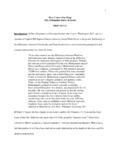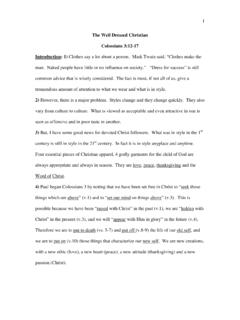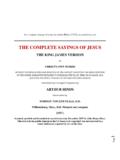Transcription of What Did Jesus Say About The End Times: Part 1 Mark 13:1-23
1 1 what Did Jesus Say About The End Times: Part 1 Mark 13:1-23 Introduction: 1) Few subjects spark greater interest than the study of eschatology or the end times. Christians and non-Christians alike are fascinated by the issue, even if they are skeptical About much of what they hear and read. Unfortunately much of this skepticism is warranted when you consider the spectacularly erroneous predictions of so many pseudo-prophets and prognosticators. 2) No one has swung and missed on the coming of the end more than the Jehovah s Witnesses whose false predictions currently stands at 9 (1874, 1878, 1881, 1910, 1914, 1918, 1925, 1975, and 1984).
2 In 1988 many evangelical Christians looked rather foolish when they were seduced by Edgar Whisenant s 88 Reasons Why the Rapture is in 1988. Not to be out done, New Age advocates cite Mayan & Aztec calendars and predict the end will come on December 21, 2012. And, I could continue down this tragic trail for quite some time. 3) Jesus addressed issues related to the end times in what is often called the Olivet Discourse since it was delivered on the Mount of Olives overlooking Jerusalem. So important was this teaching that we find it recorded in all 3 synoptic gospels (Matt 24:1-25: 46; Mark 13:1-37; Luke 21:5-36).
3 As we examine these verses we do not find Jesus encouraging us to set dates or identify the Antichrist, False Prophet or the 4 Horsemen of the Apocalypse. Rather, He admonishes us be on guard (v. 9, 23, 33) and stay awake (v. 33, 35, 37). No one but God knows when the end will come (v. 32-37). However, in light of the fact the end will come and it will come suddenly (v. 36), we must remain constantly faithful in our service to our Master (v. 35). It will not be easy, but it will be worth it all when we see Jesus .
4 2 4) Now, it must honestly be admitted that Mark 13 is a very difficult text to interpret, with faithful, Bible-believing teachers differing on the details. Some are convinced Jesus is only addressing the destruction of Jerusalem which took place in 70. Others are equally certain He has in view the end of the age and only the end of the age. I, personally, think there is a third and better understanding. Jesus does indeed address the soon coming destruction of the temple and Jerusalem. And in doing so, He provides a preview of coming attractions, that attraction being His Second Coming and the end of the age.
5 John Grassmick says it so well, Jesus predicted the destruction of the temple in Jerusalem (13:2) which prompted the disciples to inquire About the timing of these things (v. 4). Apparently they associated the destruction of the temple with the end of the Age (cf. Matt. 24:3). In reply Jesus skillfully wove together into a unified discourse a prophetic scene involving two perspectives: (a) the near event, the destruction of Jerusalem ( 70); and (b) the far event, the coming of the Son of Man in clouds with power and glory.
6 The former local event was a forerunner of the latter universal event. In this way Jesus followed the precedent of Old Testament prophets by predicting a far future event in terms of a near future event whose fulfillment at least some of His hearers would see (cf. Mark 9:1, 12-13). [BKC, 166]. 5) Jesus will employ no less than 19 imperatives in verse 5-37 as He instructs us on how to be prepared for the end times. Many of you will be surprised both by what He says and what He does not say. I. Deception is coming so do not be led astray.
7 13:1-8 Jesus leaves the temple for the last time ( ). He never returns. The glory of the Lord had departed (cf. Ezk. 11:23). One of the disciples draws attention to the magnificent splendor of the temple, one of the great architectural wonders of the world. Build with 3 large white stones and lavishly decorated with gold, it was blinding when struck by the brilliance of the sun. It truly was a marvel to behold. The Jewish people believed it be the very sanctuary of God and therefore virtually indestructible until the end of time.
8 Thus Jesus response in verse 2 could not have been more shocking, do you see these great buildings? There will not be left here one stone upon another that will not be thrown down. I have no doubt their hearts skipped a beat and their breath was taken away by these words. Verse 3 now locates them on the Mount of Olives opposite the temple. It is 2700 feet above sea level and 100 feet above Jerusalem. The inner circle of Peter and James and John and Andrew approach him privately (v. 3) and ask Him to tell them more.
9 Only Mark mentions their names. They want to know when will these things be and what will be the sign when all these things are About to be accomplished? (v. 4). The word accomplished could be translated fulfilled (NIV) and indicates the disciples are thinking About the final consummation of history. Matthew 24:3 makes this clear where we read, Tell us when will these be, and what will be the sign of your coming and of the close of the age? They did not expect a long interval between the destruction of the temple and the end of the age.
10 But, Jesus does not address the issue of timing, though He does use the soon coming destruction of the temple and Jerusalem as a type or foreshadowing of end time events. The soon destruction of the temple is the lenses through which we should view the distant destruction of this present evil age and the coming again of the Son of Man, the Lord Jesus (13:24-27). This will become evident as the text unfolds. 4 Jesus begins with a warning that is applicable to any believer at any time, See that no one leads you astray (v.)


















